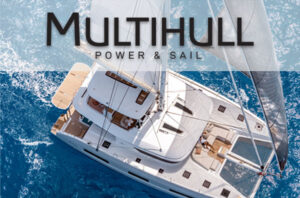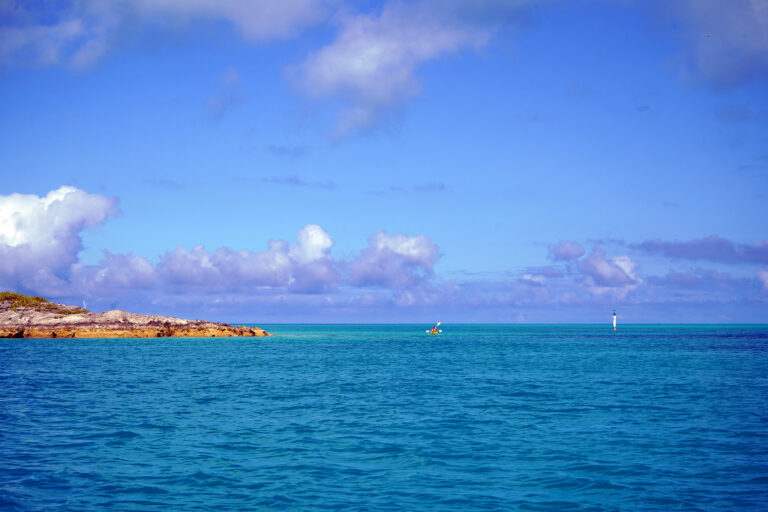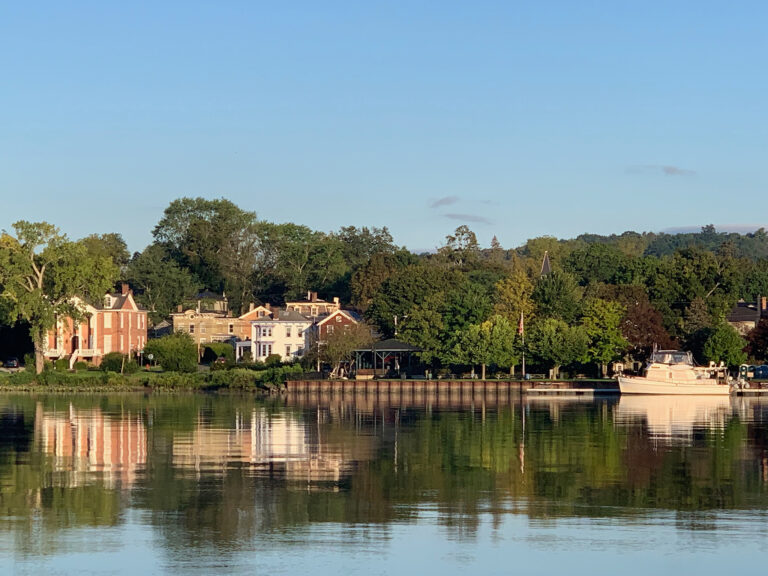Imagine a charter destination that is far away geographically—1,100 miles southeast of Miami and 100 miles east of Puerto Rico; culturally—the locals drive on the left, speak with a charming Caribbean lilt and operate on island time; and physically—with white sand beaches, azure waters and tropical flora and fauna. The U.S. Virgin Islands of St. Thomas, St. Croix, St. John and Water Island may feel like worlds apart when you’re sailing amongst them, but they can all be explored without leaving U.S. territory. This is a region that rivals any other Caribbean destination, and you don’t have to clear Customs to get in.
SNORKEL
Conditions throughout the region are ideal for snorkeling: fairly steady water temperatures of 79-83 degrees, calm seas with minimal current, and fantastic underwater scenery showcasing sea turtles, eagle rays, barracuda, Caribbean lobster (no claws on these creatures!) and schools of colorful tropical fish.
The north coast of St. John boasts an impressive lineup of beaches, all with pristine white sand. Snorkeling is popular here, especially in Trunk Bay, where the National Park Service has created an underwater snorkeling trail. Unfortunately, the popularity of anchoring and snorkeling in these waters has resulted in many dead coral heads, so the scenery can be underwhelming. However, if you grab an NPS mooring in Leinster Bay and tie your dinghy to the dinghy moorings near Waterlemon Cay, you’re likely to find an underwater menagerie on the northern side of this small island. Be sure to arrive early—there are only 20 overnight NPS moorings available, all of which are paid for on the honor system.
[advertisement]
One and a half miles off St. Croix lies uninhabited Buck Island, 176 acres of protected land surrounded by 19,000 acres of Buck Island Reef National Monument. The barrier reef is a nesting area for three species of sea turtles, and also has an underwater trail that meanders through coral grottoes, patch reefs and sea fans. The “marine garden” was first protected in 1948, proclaimed a national monument in 1961 by John F. Kennedy and enlarged to its current size while Bill Clinton was in office.
Great St. James Island, southeast of St. Thomas, is a nice place to stay on your first or last night on charter because of its proximity to both Charlotte Amalie and Red Hook. A handful of moorings are available here in the protected waters behind Fish Cay, a small island that offers superb snorkeling. When entering the mooring field, keep an eye out for snorkelers, divers, kayakers and dinghy sailors who have hopped over from St. Thomas. Then jump in and enjoy the scenery.
RACE
Whether you’re looking to shake off some cobwebs before the summer racing season begins or treat your regular crew to a change of scenery, the St. Thomas International Regatta is a grand-prix event worth checking out. Run every year since 1974, this regatta attracts some of the hottest boats and best sailing talent from around the world. Known as the “Crown Jewel” of the Caribbean racing scene, it accepts bareboats from British Virgin Island-based charter companies, like Sunsail and MarineMax, as well as locally and internationally based racing teams. The St. Thomas Yacht Club, founded in 1964, has been hosting the three-day event since its inception.
If you’re looking to race in a more modest event, check out the St. Croix International Regatta. Hosted annually in November, this regatta attracts a modest yet committed group of boats and sailors to the lovely St. Croix Yacht Club. Located on six verdant acres with a gorgeous sandy beach that overlooks Teague Bay and Buck Island National Park, the SCYC is a pleasant place to spend a few days racing in reliably windy waters.
[advertisement]
HIKE
Among the 15,000 acres of national forest on St. John, there are at least 20 distinct hiking trails, many of which originate from white-sand beaches and wend their way through arid forests past antiquated ruins. The trails range from 0.2 to 12 miles, and offer good exercise and great views. One particularly pretty jaunt is the Lind Point Trail (1.1 miles), which connects Caneel and Cruz Bays. In addition to offering a bird’s eye view of the bays, this trail allows you to walk into town if you moor in Caneel Bay, thus avoiding the crowded, rolly commercial anchorage in Cruz Bay. Farther east, the Johnny Horn Trail begins in Leinster Bay, touches on the Annaberg Ruins and continues into the town of Coral Bay. From there, you can climb 1,277 feet to the top of Bordeaux Mountain, the tallest point on the island. You could easily spend a week exploring trails, roaming this arid island where wildlife thrives amidst the soursop trees and tamarind.
Similarly, on little Water Cay, visiting sailors will also find plenty of winding pathways and absolutely no commercial traffic. From Honeymoon Bay you can walk, hike or jog up “Kick Your Butt Hill” trail (so called by locals), concluding with a burger at Heidi’s Beach Bar.
PICNIC
For a picnic unlike any other, check out Little Lameshur Bay on St. John’s south side. This well-kept National Park site is a hive of activity during the day, with dozens of tourists staying on St. John stopping in for some snorkeling or to make use of the public picnic tables, grills and bathrooms. But when the sun goes down and the tourists return to their cabanas, you’ll have the beach to yourself. Grill up some fresh fish and plop down on a picnic table with your toes in the sand as the sun disappears in the west. This anchorage is just far enough out of the way that you’re unlikely to have many neighbors at night, save for the occasional porpoise or sea turtle.
SHOP
For the souvenir hunters in your crew, this part of the world offers a plethora of shopping options. On St. John, the small artist colony of Mongoose Junction, nestled in the hills above Cruz Bay, offers handmade gifts and trinkets made by artists from around the Caribbean. Pick up primitive-styled clothing, beads or baskets at Bamboula (named after a local traditional dance), shop at Friends of the Park Store for gifts that support a sustainable environment or stop by the Sun Dog Café, which overlooks a courtyard that’s always pumping with local music. If it’s duty-free loot you’re after, visit Charlotte Amalie on St. Thomas, where the modern streets and alleys of Havensight offer deals on jewelry, alcohol, perfumes, art and clothing. On St. Croix, you could easily spend a day perusing the shops in Christiansted and then make your way to nearby Gallows Bay—via the meandering, picturesque boardwalk—to enjoy the boutiques and restaurants there.
DIVE
According to CYOA Yacht Charters, based in Frenchtown in Charlotte Amalie, charter guests who are certified divers can bring their own gear (and pay a $500 security deposit to ensure the integrity of the boat) or rent snorkel gear from a local watersports center for $150 a week. Alternatively, if you’re only planning to dive once or twice, CYOA recommends setting up a rendezvous dive with a company such as Admiralty Dive Center, in which the company meets you at your boat, brings all the gear, takes you to a great dive spot, and then returns you to your boat when the dive is over. The cost is around $80 for two tanks.
Twin Barges, located off Limetree Beach on St. Thomas, showcases two side-by-side wrecks that sunk sometime around the 1940s. Though visibility in the surrounding water can be cloudy, the clarity within the ships’ two hulls is fantastic. Another great wreck, the 190-foot steel freighter Cartanser Senior, is located in a cove on the west side of Buck Island. Originally used to ship goods during WWII, she was abandoned in a cove on St. Thomas in 1970 and sank to a silt-covered bottom, rendering her cloudy and uninteresting to divers. However, when the Army Corp of Engineers decided to destroy the “navigational hazard,” a group of locals organized a “Save the Cartanser” campaign and had her moved five miles offshore to her current resting ground. Their motivation was two-fold: they wanted to preserve their sweet dive site, and they wanted to create a tourism opportunity mirroring that of the wreck of the Rhone in the British Virgin Islands, to which dive enthusiasts have swarmed since it was featured in the film The Deep. By all accounts, they’ve succeeded. Today, the Cartanser is a super dive, and her remains attract all variety of marine life: yellowtails, tang, group, angel fish and more.
LEARN
What better place to learn to sail than in a liveaboard sailing class in the Virgin Islands? At Virgin Island Sailing School (sailusvis.com), classes are taught aboard a 47ft Leopard catamaran, Silver Lining, and a fleet of J/24s. The combination ensures a well-rounded curriculum in which you learn both basic sailhandling and bareboat logistics. Based in St. Thomas, the school’s curriculum typically covers ASA 101, 103 and 104 as you travel to St. John, Jost Van Dyke, Tortola, Anegada and Norman Island. Similarly, Fair Wind Sailing School, based in Red Hook, St. Thomas, offers courses aboard their Leopard 45 and Leopard 42 catamarans. Students can choose between a three-day intensive catamaran sailing class, perfect for experienced monohull sailors interested in learning the intricacies of a charter cat, or “Instant Bareboater,” a seven-day liveaboard course that covers everything from anchoring, mooring and provisioning to navigation, engine maintenance and more.
[advertisement]
PARTY
No matter where you go in the Caribbean, you’ll hear folks talking about “Carnival.” This multi-day celebration takes on different forms in each of the Caribbean nations, but all carnivals have roots in the African and European cultures that blended to create the island populations of today. From Africa comes drumming, dancing, costumes, and creole food and music. From Europe comes parades, pageants, and traditional music and dances, including the quadrille. In the 1700s and 1800s, during the age of slavery, Carnival was segregated and displays of African culture were discouraged or banned. But by the mid 1900s, Carnival had evolved into a unique multicultural Caribbean celebration, known for its incredible costumes, spectacular food and music and amazing parades that snake through the streets for days on end.
On St. Thomas, Carnival was revitalized by a radio personality back in 1952, and islanders there have been celebrating for three weeks a year ever since, with a special emphasis on the Easter Week holidays. On St. Croix, Carnival (also known as the Crucian Christmas Festival) falls around the Christmas holidays and lasts for four weeks, starting with the Miss St. Croix Pageant in mid-December and ending with the Three Kings Parade in early January. On St. John, Carnival begins in June and lasts through early July to celebrate both U.S. Independence Day and Emancipation Day—a local holiday commemorating the abolition of slavery.
Though Carnival is perhaps the best-known Virgin Islands celebration, there are other festivals worth visiting as well, including the St. Croix Food and Wine Experience, an international culinary celebration in April, and the St. John Arts & Music Festival, which showcases local and international artists in the Cruz Bay artist colony in mid-February.
SUP
There are few better places to dive into this latest watersports phenomenon than the waters of the USVI, where wave action can be fairly minimal close to shore and where the water feels fine if you fall in. Several charter companies rent SUPs for a week at a time, and these can be easily stowed along the side deck of a beamy catamaran. Otherwise, if you’re only interested in paddling for a day, there are plenty of places to rent, join guided tours or take lessons. At SUP-stJohn.com, the company delivers the SUP to your boat for prices ranging from a rental inflatable SUP for $30/hour to $75 for a two-hour private lesson.
BIRDWATCH
St. John is unique among Caribbean islands for both its biodiversity and its unspoiled forest. The island boasts more than 800 species of plants, and its forests are ecologically important for the migratory birdlife they support. You may catch a glimpse of the Antillean Crested Hummingbird feeding on a yellow Century plant blossom, or see a migratory songbird like the Northern Parula or the black and white Warbler take flight. Though the Warbler spends most of the year in North America, it winters on St. John to make it through the colder months.
The dry woodland forests, replete with fruits and seeds, support large populations of Mangrove Cuckoo, Caribbean Elaenia and Bananaquit Honeycreeper. Lining the ocean shore, on the hunt for small fish and invertebrates, are waders like the Brown Pelicans, Brown Boobies, Little Blue Herons and Frigatebirds while inshore wetlands support White-cheeked Pintail Ducks and Black-Necked Stilts
Meanwhile, Buck Island preserve off St. Croix serves as a nesting ground for both endangered Brown Pelicans and threatened Least Terns. The Pelicans nest from June through March, while the Terns nest on open sandy beaches from May to August. On and around Buck Island you may also see Bananaquits, Gray Kingbirds, Greenthroated Hummingbirds, Kestrels, Pearly-eyed Thrashers and Zenaida Doves.
When the United States purchased St. Croix, St. Thomas and St. John from Denmark in 1917, the islands were sparsely populated. Most of the inhabitants could trace their ancestry back to the West African slaves who once worked on the many sugar plantations. But as leisure time and disposable income increased following World War II, more Americans began to travel to the U.S. Virgin Islands and many fell in love with them. The 1960s saw an explosion in the charter sailing industry, as well as an increase in conservation efforts: philanthropist Laurance S. Rockefeller acquired 5,000 acres on St. John and turned it into a National Park in 1956; Congress added 5,650 acres of submerged land in 1962; and so the vacation paradise we know today was born.
Multihull Charter Companies Serving the USVI
BVI Yacht Chartersbviyachtcharters.com (Road Town, Tortola)
Catamaran Companycatamarans.com/charter (Hodges Creek Marina, Tortola)
Conch Chartersconchcharters.com (Road Town, Tortola)
CYOA Yacht Charterscyoacharters.com (Charlotte Amalie, St. Thomas)
Dream Yacht Chartersdreamyachtcharter.com (Hodges Creek Marina, Tortola)
Fair Wind Sailing Schoolfairwindsailing.com (Red Hook, St. Thomas)
Footloose Chartersfootloosecharters.com (Road Town, Tortola)
Horizon Yacht Chartershorizonyachtcharters.com (Nanny Cay, Tortola)
MarineMaxVacationsmarinemaxvacations.com (Hodges Creek Marina, Tortola)
The Mooringsmoorings.com (Road Town, Tortola)
Sail Caribesailcaribe.com (Fajardo, San Juan)
Sunsailsunsail.com (Road Town, Tortola)
TMM Yacht Charterssailtmm.com (Road Town, Tortola)








